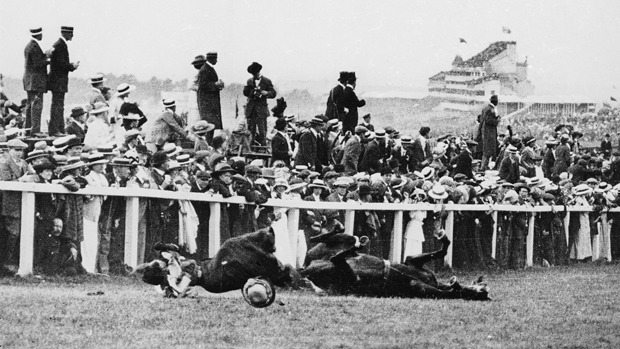Emily Davison: The true story of the Epsom derby martyr
Suffragette's fatal attempt to halt king's horse became legendary symbol of women's right to vote

On 4 June 1913, Emily Wilding Davison passed into the annals of British history when she rushed onto the course at the Epsom derby and was trampled by the king's horse.
By the time the 40-year-old veteran suffragette died of her injuries, four days later, she had already become a symbol of the struggle for women's rights.
However, the exact circumstances of her death have long been disputed. Many of her fellow suffragettes, including Emmeline Pankhurst, thought that Davison had deliberately leapt into the path of the horses. The theory was credible to those who knew Davison personally – she was reckless when it came to activism and had once tried to martyr herself by jumping off a staircase while being held in Holloway Prison – but it is almost certainly untrue, says The Guardian.
The Week
Escape your echo chamber. Get the facts behind the news, plus analysis from multiple perspectives.

Sign up for The Week's Free Newsletters
From our morning news briefing to a weekly Good News Newsletter, get the best of The Week delivered directly to your inbox.
From our morning news briefing to a weekly Good News Newsletter, get the best of The Week delivered directly to your inbox.
A 2013 Channel 4 documentary used new technology to examine the grainy newsreel footage of Davison's fatal leap in more detail than was ever previously possible.
Their analysis concludes that Davison was attempting to place a pro-suffrage sash on the king's horse and did not intend to kill herself, as many had speculated. This tallies with other evidence, such as the fact that a return train ticket was found on her person. [[{"type":"media","view_mode":"content_original","fid":"95469","attributes":{"class":"media-image"}}]]
Although women's suffrage would not be granted until 1918, the symbolic power of Davison's shocking death, one of the first news tragedies to be captured on camera, was felt immediately.
Crowds packed the streets to witness 6,000 women march in Davison's funeral procession, and a Votes for Women rally in Hyde Park the following month, attracted 50,000 demonstrators. Fifteen years later, jockey Herbert Jones, who was thrown from the saddle and concussed in the 1913 collision, attended Emmeline Pankhurst's funeral and laid a wreath in remembrance of her and Davison.
A free daily email with the biggest news stories of the day – and the best features from TheWeek.com
Women's political, economic and social rights have undergone a massive transformation since Davison's day, but her daring and passion still strike a chord in modern Britain. Film director Danny Boyle revealed how a visit to a plaque in the Houses of Parliament commemorating Davison – who hid in a cupboard there on census night in 1911 in order to have it listed as her address and be able to claim the same political rights as men – helped inspire his 2012 Olympics opening ceremony.
"I stood in the darkness of the cupboard thinking, 'Emily Wilding Davison slept here, then two years later died trying to put a suffragette sash round the King's horse'," Boyle told The Mirror.
"We started to think about more hidden stories, the people who make those stories and how those stories are retold."
-
 How to financially prepare for divorce
How to financially prepare for divorceThe Explainer Facing ‘irreconcilable differences’ does not have to be financially devastating
-
 Why it’s important to shop around for a mortgage and what to look for
Why it’s important to shop around for a mortgage and what to look forThe Explainer You can save big by comparing different mortgage offers
-
 4 ways to save on rising health care costs
4 ways to save on rising health care costsThe Explainer Health care expenses are part of an overall increase in the cost of living for Americans